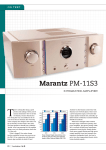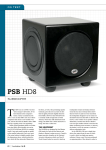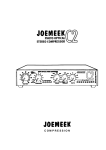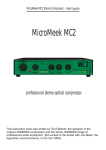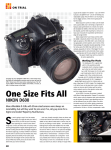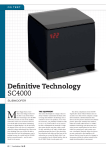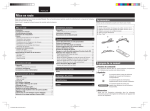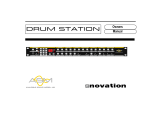Download Sunfire HRS-10 Subwoofer Review and Test
Transcript
ON TEST Sunfire HRS-10 Subwoofer I ’m not so sure about Sunfire’s slogan for its HRS-10 subwoofer: ‘Ten inches. Countless hours of enjoyment.’ but it certainly got my attention. It refers, of course, to the diameter of the front-firing bass driver in Sunfire’s otherwise tiny HRS-10 subwoofer. There’s also a reference to it containing a 1,000-watt amplifier, but I let that one pass through to the keeper. And when I say ‘otherwise tiny’—in Sunfire’s specification sheet, where they’re supposed to give the usual height × width × depth dimensions, the wording instead says only ‘11.5-inch cube.’ I was going to convert that into millimetres for local consumption, until I saw the unit in the flesh and then realised that it’s not quite 38 Australian a cube: it actually measures 295×295×315mm (HWD) if you include the protrusions on the rear panel (mainly its the speaker input terminals that protrude). So although it’s not quite a cube, it is definitely very small. The Equipment I have become rather used to ‘shoebox’ subwoofers (if I’m allowed to call them that) having multiple drivers, because in order to get high SPLs from such a small cabinet, designers nearly always harness the acoustic output from both sides of the driven cone, and use one or two passive radiators to accomplish this. So the HRS-10 is unusual for its ilk in having just a single bass driver and, what’s more, it’s in an infinite baffle (sealed box) enclosure—so not only are there no passive radiators to help deliver deep bass, neither is there a bass reflex port. This means that the bass driver has to work very hard indeed to rarefy the air inside the cabinet when it’s moving outward, and compress it when it’s on its inwards journey. Which is why the amplifier inside the Sunfire is rated at 1,000-watts. But how can Sunfire fit a 1000-watt amplifier inside such a small enclosure, with no external heatsinks? The answer is that the amplifier uses a circuit topology patented by Bob Carver (the founder of Sunfire), that uses what both Carver and Sunfire call ‘Tracking Sunfire HRS-10 Subwoofer Converter’ technology. According to Carver’s patent (US#6,104,248) for this circuit, it is an audio amplifier with a tracking power supply that uses inductive power converters to provide positive and negative amplifier operating potentials of a magnitude that exceeds the d.c. voltage available to power the amplifier. It must be said that the basic idea behind the patent is not new. Osamu Hamada, of Sony, worked on just such an idea back in 1977 and was in fact awarded a US patent for his work in that same year (prior to Carver’s patent). Hamada’s patent abstract is such wonder of brevity that it deserves to be reproduced here verbatim: ‘An amplifier circuit where the power supply voltage of an amplifier is modulated by a signal having a waveform that corresponds, at least in selective parts, to the waveform of the signal being amplified by the amplifier.’ You can see what Hamada is describing is what’s commonly known as a ‘Class-H’ amplifier, which itself is simply a variant of a standard Class-A/B amplifier except that rather than having a fixed rail voltage, a Class-H amplifier tracks the input signal and modulates the voltage on the supply rails. (Many people confuse Class-H with Class-G. In Class-G, there are multiple fixed rail voltages and the amplifier switches to the one that’s most appropriate, so the rail voltage changes, but only in discrete steps.) So far as I can see, Carver’s ‘Tracking Downconverter’ is just a slightly different way of achieving Class-H operation by using inductive power converters. Esoteric technical quibbles aside, the main advantage of Class-H operation is that there’s very little power dissipated anywhere in the circuit, either in the power supply itself or the output stages, so there’s almost no heat generated, therefore no need for heatsinks. There’s also almost no stress on any of the components because they’re only called on to work when they’re actually required to do so, whereas in a conventional amplifier—especially a Class-A design—many components are working flat-out even when there’s no signal at all. The other advantage is the possibility of very high power output levels because whereas it’s very expensive to build a conventional power supply with a rail voltage high enough to enable high power output, it’s fairly cheap to build one with a variable rail. Indeed this is one of the very reasons for using it that’s given by Carver in his ‘White Paper’ on the subject: that it ‘costs far less’ than any other design with the same power output. Understandably, because of the high There’s very little power dissipated anywhere in the circuit: in the power supply or the output stages power capability of the amplifier, the circuit has a signal compressor that cuts in to protect the HRS-10’s bass driver from excessive power. However, if this happens, it also triggers a soft-clipping circuit, so the sound appears to be louder, even though the signal is being compressed. It’s an unusual application for a soft-clipping circuit. What of the HRS-10’s bass driver? It’s a tough-looking design with an overall diameter of 280mm but a Thiele-Small diameter of 205mm, for an Sd of 330cm². The cone appears to be made from heavy-duty paper, made even more rigid by a 110mm diameter dustcap. The surround appears to be made from high-density foam. The amplifier’s controls are quite sparse, comprising a volume control, a rotary phase control (0 – 80°) and a rotary crossover control (30 – 100Hz). According to Sunfire, the fully-clockwise position of the crossover control invokes a ‘crossover by-pass’ (for those using the HRS-10 in conjunction with a home theatre receiver with its own crossover control built in.) One problem I had with the controls was that Sunfire has used dark grey lettering on a black background to identify the controls and their settings. As a result I found it really difficult to read… but then I do have poor eyesight. There are line-level inputs and outputs (via RCA terminals) and speaker level inputs (but no speaker-level outputs). The line-level outputs are high-passed at 70Hz so if you have small bookshelf speakers, you can use the subwoofer to filter out low-frequencies so that neither the amplifier driving your bookshelf speakers, nor the speakers themselves, will have to handle deep bass—that will be delivered by the HRS-10. (This hook-up does require you to use separate pre and power amplifiers, or an integrated amplifier with pre-in/main-out terminals that can operate independently.) The mains power switch is a rocker switch that uses US-orientation (‘Up’ is ‘Power-On’ and ‘Down’ is ‘Power-Off), which is a bit confusing for us down under. When the subwoofer is switched on, its operational mode is controlled by ON TEST signal-sensing. It will switch on the instant it detects an audio signal at either the RCA or speaker-level inputs, then will switch itself to standby automatically around 15 minutes after it last detects an audio signal. A quick note on the packaging, because I don’t think I’ve ever seen a subwoofer that’s been so well packed. The HRS-10 is supplied protected by polystyrene ‘corners’ in a box, which is protected by another box with wood pulp corners, which is protected by yet another box etc…it’s a little like a Russian doll! An equally quick note on Sunfire’s User’s Manual: it’s very good! It’s well-produced, Sunfire HRS-10 Subwoofer Brand: Sunfire Model: HRS-10 Category: Subwoofer RRP: $1,699 Warranty: Two Years Distributor: Qualifi Pty Ltd Address: 24 Lionel Road Mt Waverley VIC 3149 1800 242 426 (03) 8542 1111 [email protected] www.qualifi.com.au • Amazing bass! • Tiny size • Ease of positioning • Knobs and lettering • Needs bookshelf-size satellites • Too wife-friendly LAB REPORT Readers interested in a full technical appraisal of the performance of the Sunfire HRS-10 Subwoofer should continue on and read the LABORATORY REPORT published on page 82. Readers should note that the results mentioned in the report, tabulated in performance charts and/or displayed using graphs and/or photographs should be construed as applying only to the specific sample tested. Lab Report on page 82 avhub.com.au 39 ON TEST Sunfire HRS-10 Subwoofer well-written, and has good diagrams showing various modes of hooking-up components and useful information about subwoofer positioning. In Use and Listening Sessions After correctly positioning the subwoofer (the information in the manual is exactly what I’d recommend, but if you want some even more-detailed information, you’ll find it here: www.tinyurl.com/subwoofer-placement ), I had to set the volume, phase and crossover frequency, during which I couldn’t help but discover the fairly ordinary quality of the three rotary control knobs, plus the fact that one of them was slightly off-centred, so it scraped on the amplifier casing over part of its travel. I realise that most people will only ever use these controls just once or twice, but spending just a few cents more on superior knobs would make a better first impression. One problem with really small subwoofers like this Sunfire HRS-10 is that if you put them in the ideal sonic position in a room, and this happens to be in a trafficked area, it’s quite easy to accidentally trip over them, because they’re so small they’re not really in your eye-line. So you should always investigate a ‘second-best’ position if it’s more out-of-the-way or, alternatively, consider putting an item of furniture (such as a small side table or flower-stand) over the top of it. Remember, too, that the HRS-10 is so small it could actually be placed on a bookshelf, rather than on the floor, which increases the range of positioning options enormously. Also, so far as subwoofers are concerned, they don’t care (acoustically-speaking) whether they’re near a floor or a ceiling, so if you have a very high cupboard or bookcase, the HRS10 is so small it could easily be placed on the top of that, out of harm’s way and also out of sight! The bass from the HRS-10 subwoofer is, literally, unbelievable. And when I say ‘literally’, I mean it. Even I could not believe the depth and level of bass it was producing in my listening room. What’s more, it was tight, ‘thwacky’ bass—no rounded, plummy midrange-y overtones here! This was particularly impressive with sharp, short-duration low-frequency sounds, such as a close-miked kick drum, or plucked bass, and was equally impressive with movie sound effects. It didn’t disappoint with sustained sounds, either. Many cello masterpieces require the cellist to play notes within the HRS10’s ambit, and when I played these, the cello tone was delivered beautifully. The same is even more true of works for pipe organ. There’s no better recording to demonstrate the bottom end of a sub than Dorian’s recording (DOR-90134) of the organ of the Church of Saint Eustache, which, with 8,000 pipes, including a 32-footer, is the largest pipe organ in France. Dorian’s recording features Jean Guillou playing some crowd favourites composed by Bach, Mozart, Liszt and Charles-Marie Widor, plus Guillou’s own, rather less well-known, Hyperion. So long as I didn’t try to play too loud (though it was very tempting to do so) the Sunfire HRS-10 reproduced the low-frequencies fabulously well all the way down to around E0, though I wasn’t quite sure about the bottom pedal note at 16Hz. What was missing entirely was the feeling of my internal organs being vibrated, which is what happened when I attended a recital at Saint Eustache when I was in Paris on holiday…but that, of course would be asking just too much from such a tiny sub. (If you’re in Paris, around Les Halles, I recommend you take the time to attend a recital or two at Saint Eustache. Although most churches in France have regular recitals, Saint Eustache’s musical programming is better than most. Its choir is above-average too!) And what happened when I did play too loudly? The Sunfire behaved very gracefully. I did not hear any real distortion, and I certainly didn’t hear any damaging voice-coil poling, and I didn’t really hear any overtlyobvious compression… though there was just a little. It seems that in marrying a compression circuit with a soft-clipping circuit Sunfire has found a perfectly musical answer to the issue of overpowering! This means that even if you make a user-error you need have no fear of accidentally damaging your subwoofer. Speaking of which, overpowering a subwoofer is primarily a function of having chosen a subwoofer that’s just too small for your room. Room volume is always an important consideration when selecting a subwoofer, just as it is when choosing loudspeakers, and the general rule-of-thumb is that the bigger the room, the bigger the subwoofer that’s required. Sunfire says the HRS-10 is recommended for areas up to 37 square metres. If your floor area is any larger than this, or your floor area is around 37m² but you have higher-than-usual ceilings, the next step up (at least in Sunfire’s HRS range) would be the HRS-12. (And if your room is less than 14m², you could get away with the slightly less expensive HRS-8, but remember that there’s no harm in buying a subwoofer that’s technically ‘too big’ for the room it’s in.) This room volume equation applies only if you want to turn your subwoofer up really loud—at low-to-average levels, it isn’t as important to get a perfect match. (And if at some stage you do require additional volume, it’s as easy as adding a second subwoofer.) Because the range of frequencies over which the Sunfire HRS-10 delivers its best bass performance is a little restricted at the upper end of its operating range as well as the low end, you’ll need to exercise a little bit of care when matching it with your main speakers. Whereas subwoofers in large cabinets mostly roll off fairly gently and naturally usually above 150–200Hz, so you can integrate them with tiny satellite speakers, the HRS-10’s high-frequency response rolls off quite rapidly above 100Hz, so you’ll need to use bookshelf/stand-mount speakers which have bass/midrange driver diameters of around 160mm or more in order to successfully integrate them with the HRS-10. Conclusion Even if you’re not in the market for a subwoofer, it would be worth dropping in on your nearest Sunfire dealer to audition the HRS-10… and maybe take a friend so that afterwards you can both chat animatedly about how amazed you were, and that you wouldn’t have believed you could get such good bass from such small enclosures. But whatever you do, don’t take the wife, otherwise she’ll know not to believe you when you tell her that in order to get great bass, you’ll just have to buy that large subwoofer you’ve been lusting after for the last few years! Jutta Dziwnik LAB REPORT ON PAGE 82 40 Australian LAB REPORT Sunfire HRS-10 Subwoofer CONTINUED FROM PAGE 40 Laboratory Test Report The nearfield frequency responses measured by Newport Test Labs (using a sinus test signal) show that the Sunfire HRS-10 has a very narrow pass-band. As you can see, irrespective of the setting of the crossover control, its low-frequency response rolls off rapidly below 25Hz. The high-frequency response starts rolling off gradually above 60Hz, then steeply above 100Hz, though these roll-offs are of course affected by the setting of the crossover control. It would appear that the fact that the crossover is bypassed makes no difference to the subwoofer’s response, as you can see from the similarities in the responses with the crossover control set to 100Hz (green trace) and by-pass (pink trace). Overall, as shown by this particular measurement technique, the frequency response of the HRS-10 was 22Hz to 100Hz ±5dB, this obtained with the crossover set to 100Hz. (In checking against Sunfire’s specifications, I noted that although Sunfire claims a ‘response’ of 20Hz to 100Hz for the HRS-10, it does not state dB limits, so it’s not claiming a ‘response’ at all, but instead a ‘range’ of frequencies over which the subwoofer will operate, which is technically meaningless. Figure 2 shows the Sunfire HRS-10’s response using a pink noise test signal, which means that some of the second and third-order harmonic distortion components will be included in the measurement (just as it would be with music), slightly raising the overall levels at higher frequencies, and you can see that with this test signal, Newport Test Labs’ graphing shows the frequency response of the Sunfire HRS10 as 22Hz to 100Hz ±3dB, which is marvellous. You can see from these traces that with the crossover set to 100Hz, the response is the most extended, but there’s an emphasis across the range 35–75Hz, peaking at 55Hz (this peak is more obvious on Graph 1). The responses are far ‘flatter’ below 70Hz at the 65Hz (‘Normal’) and 30Hz settings of the crossover control, with the ‘Normal’ setting giving a response of 25Hz to 70Hz ±1dB, which is amazingly flat. Figure 3 shows the frequency response of the line output of the Sunfire HRS-10 and it appears that although it’s high-pass filtered as claimed, the filter is both fixed and very shallow, attenuating the signal at only 3dB per octave with around a 100Hz turnover, so response is only 6dB down at 30Hz. This means that if you use Sunfire’s recommended system of looping the audio signal through the subwoofer before going to your main speakers, those speakers will still receive appreciable levels of low-frequencies, albeit slightly attenuated. Overall, Newport Test Labs’ tests on the Sunfire HRS-10 show excellent performance across its operating range, but also that that range is narrower than that delivered by subwoofers with much larger (and sometimes multiple) drivers operating from cabinets of considerably larger internal volume (and thus external dimensions). Steve Holding Newport Test Labs 105 100 95 90 85 80 75 70 65 60 55 50 The frequency response of the Sunfire HRS-10 was measured as being 22Hz to 100Hz ±3dB, which is marvellous. dBSPL 110 10 Hz 20 30 40 50 60 70 80 90 100 200 Figure 1: Nearfield frequency responses showing response of bass driver with crossover set to 30Hz (red trace), 65Hz (Blue Trace), 100Hz (green trace) and By-Pass (pink trace). 110 dBSPL Newport Test Labs 105 100 95 90 85 80 75 70 65 60 55 50 10 Hz 20 30 40 50 60 70 80 90 100 200 Figure 2: Pink noise frequency responses (smoothed via post-processing) measured at 2.0 metres with crossover control at 30Hz (red trace), 65Hz (Blue Trace), 100Hz (green trace). 10 dBm Newport Test Labs 5 0 -5 -10 -15 -20 -25 -30 -35 -40 20 Hz 30 40 50 60 70 80 90 100 Figure 3: Frequency response of subwoofer's line output terminals (response is same for all settings of the crossover control. [Sunfire HRS-10 Subwoofer] 82 Australian 200 Subscribe And Save BeTTeR THan SonoS? REVIEWED Yamaha A-S3000 Integrated Amplifier Marantz CD5004 (See page 34) CD Player Wilson Audio Alexia Speakers PureAudio Vinyl Phono Preamplifier Xavian Bonbonus Loudspeakers November/December 2013 CZECH THE COLOURS! January/February 2014 Read the review… Hear the sound… HI-RISE HI-FI Kiwi designer in Singapore’s Adelphi Centre FATHER OF HI-FI Marantz knocks our socks off with the PM-11S3 amplifier Memories of Gilbert Briggs, founder of Wharfedale A$8.95 NZ$10.99 Rejoice! www.avhub.com.au HF Nov13_001 Cover.indd 1 10/4/2013 12:31:48 PM SHOW REPORT High End Munich September/October 2013 DUAL VALVES! 300B or KT88? Full review and test of AudioSpace’s innovative amplifier... A$8.95 NZ$10.99 www.avhub.com.au aLSo ReVIeWeD Focal Chorus 706 AVHUB.COM.AU A$8.95 NZ$10.99 HF Sep13_001 Cover.indd 1 ALSO REVIEWED Speakers Krix Phoenix V2 Loudspeakers PSB HD8 Subwoofer Sunfire HRS-10 Subwoofer Project RPM 1.3 Genie Turntable VTL MB-125 Amplifier Bricasti Design M1 Digital-To-Analogue Converter 8/26/2013 2:46:54 PM Subscribe to Australian Hi-fi magazine and you can save over $32.00 on the cover price! avhub.com.au 83





